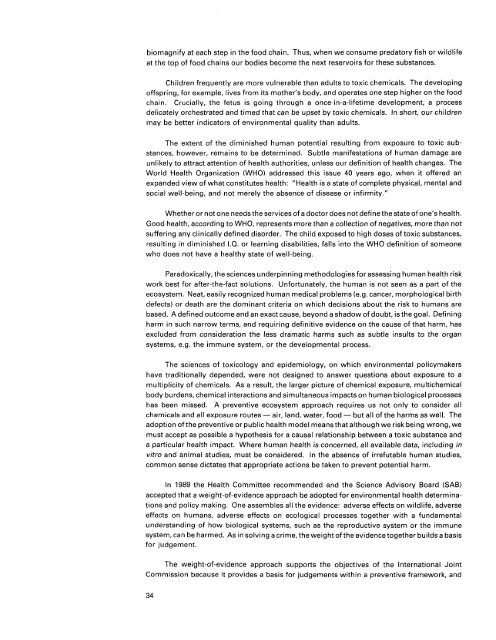International Joint Commission
International Joint Commission
International Joint Commission
You also want an ePaper? Increase the reach of your titles
YUMPU automatically turns print PDFs into web optimized ePapers that Google loves.
iomagnify at each step in the food chain. Thus, when we consume predatory fish or wildlife<br />
at the top of food chains our bodies become the next reservoirs for these substances.<br />
Children frequently are more vulnerable than adults to toxic chemicals. The developing<br />
offspring, for example, lives from its mother's body, and operates one step higher on the food<br />
chain. Crucially, the fetus is going through a once-in-a-lifetime development, a process<br />
delicately orchestrated and timed that can be upset by toxic chemicals. In short, our children<br />
may be better indicators of environmental quality than adults.<br />
The extent of the diminished human potential resulting from exposure to toxic substances,<br />
however, remains to be determined. Subtle manifestations of human damage are<br />
unlikely to attract attention of health authorities, unless our definition of health changes. The<br />
World Health Organization (WHO) addressed this issue 40 years ago, when it offered an<br />
expanded view of what constitutes health: "Health is a state of complete physical, mental and<br />
social well-being, and not merely the absence of disease or infirmity."<br />
Whether or not one needs the services of a doctor does not define the state of one's health.<br />
Good health, according to WHO, represents more than a collection of negatives, more than not<br />
suffering any clinically defined disorder. The child exposed to high doses of toxic substances,<br />
resulting in diminished 1.0. or learning disabilities, falls into the WHO definition of someone<br />
who does not have a healthy state of well-being.<br />
Paradoxically, the sciences underpinning methodologies for assessing human health risk<br />
work best for after-the-fact solutions. Unfortunately, the human is not seen as a part of the<br />
ecosystem. Neat, easily recognized human medical problems (e.g. cancer, morphological birth<br />
defects) or death are the dominant criteria on which decisions about the risk to humans are<br />
based. A defined outcome and an exact cause, beyond a shadow of doubt, is the goal. Defining<br />
harm in such narrow terms, and requiring definitive evidence on the cause of that harm, has<br />
excluded from consideration the less dramatic harms such as subtle insults to the organ<br />
systems, e.g. the immune system, or the developmental process.<br />
The sciences of toxicology and epidemiology, on which environmental policymakers<br />
have traditionally depended, were not designed to answer questions about exposure to a<br />
multiplicity of chemicals. As a result, the larger picture of chemical exposure, multichemical<br />
body burdens, chemical interactions and simultaneous impacts on human biological processes<br />
has been missed. A preventive ecosystem approach requires us not only to consider all<br />
chemicals and all exposure routes - air, land, water, food - but all of the harms as well. The<br />
adoption ofthe preventive or public health model meansthat although we risk being wrong, we<br />
must accept as possible a hypothesis for a causal relationship between a toxic substance and<br />
a particular health impact. Where human health is concerned, all available data, including in<br />
vitro and animal studies, must be considered. In the absence of irrefutable human studies,<br />
common sense dictates that appropriate actions be taken to prevent potential harm.<br />
In 1989 the Health Committee recommended and the Science Advisory Board (SAB)<br />
accepted that a weight-of-evidence approach be adopted for environmental health determinations<br />
and policy making. One assembles all the evidence: adverse effects on wildlife, adverse<br />
effects on humans, adverse effects on ecological processes together with a fundamental<br />
understanding of how biological systems, such as the reproductive system or the immune<br />
system, can be harmed. As in solving a crime, the weight ofthe evidence together builds a basis<br />
for judgement.<br />
The weight-of-evidence approach supports the objectives of the <strong>International</strong> <strong>Joint</strong><br />
<strong>Commission</strong> because it provides a basis for judgements within a preventive framework, and<br />
34

















